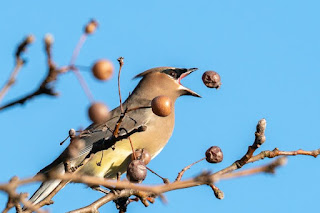Well, that seems like an easy question, right? Yet when it
comes to invasive plant spread, some people continue to be unaware of how invasive
plants get around (the classic answer is: “It never spreads in my yard, I don’t
think it’s invasive.”). I think a refresher on the birds and the bees seems to
be in order.
 |
| Callery pear fruit |
Invasive plants arrive here in different ways originally, but once they’re here they spread thanks to the 3 W’s: wind, water, and wildlife (not including those that spread by runners). Of course, some plants were specifically encouraged to support wildlife; the plants known as thorny and autumn olive (Elaeagnus sp.) are in that group. They’ve since become one of the top invasive plants in Georgia and the southeastern US, and they continue to be sold and planted today.
Fruit-bearing invasive plants are often spread by birds as
they eat them, fly some distance away, and deposit the seeds of the fruit in
new places. This behavior by birds leads some people to believe that there is a
net positive impact on the ecosystem if birds are able to eat the fruits. What
is not well understood is that these fruits are often not the food of choice
for these birds but rather one of low
nutrition or last resort. Poor nutrition can slow migration and make birds
vulnerable to other risks. One particular non-native plant, Nandina domestica, actually has fruits
that can be toxic to cedar waxwings because they can gorge on fruits.
 |
| Cedar Waxwing eating Pyrus calleryana in winter. Photo from Pilot Online Original Source: Carol Annis |
Once humans know better, we can help heal the habitats that our native birds share with us. Our landscapes were planted after native plants were removed from the site. It’s not just our yard, it’s a million yards, billions of acres that have been disrupted one acre at a time, but we can begin to stitch some back together and create new habitat. Plants which fed birds then – native plants – can be added back.
Fruit-bearing native plants produce fruit from spring to fall
(starting with black
cherry), but let’s focus on what migrating birds are eating in the fall and what winter residents are eating in the winter since we’re in the here and now.
Fruits
for fall migrating birds include native viburnums, spicebush (Lindera benzoin), beautyberry
(Callicarpa americana), shrub dogwoods (e.g., Cornus amomum), most hawthorns
(Crataegus) as well as late blueberries (Vaccinium arboreum) and blackberries
(Rubus).
In the winter in Georgia, native plants with late or persistent
fruits include flowering dogwood (Cornus
florida, or now known as Benthamidia
florida ), green hawthorn (Crataegus
viridis), native
shrub and tree form hollies (Ilex),
and eastern
redcedar (Juniperus virginiana).
These native fruit-bearing plants benefit not just birds
that eat fruits but also others. Native plants will also offer beneficial
support to insectivores because butterflies and moths can use native plants for
caterpillars. Native plants support birds in far more ways that fruit and that
is their superpower advantage over non-native plants.

















